Beans and legumes hold a significant place in the vegan lifestyle, offering a versatile and nutritional source of protein, fiber, and essential nutrients. This essential guide delves into the numerous health benefits of beans and legumes, the diverse variety of beans available, cooking techniques, vegan bean-based protein sources, and the art of seasoning and flavoring bean dishes. From tantalizing soups, stews, and salads to hearty main dishes, finger-licking snacks, and even delicious desserts, this comprehensive exploration of vegan bean dishes will not only inform but inspire you to incorporate more beans into your everyday meals.
The Health Benefits of Beans and Legumes for Vegan Dishes
Beans and legumes have been lauded for their numerous health benefits, making them an ideal protein source for vegan dishes. One of the primary advantages of including these foods in your diet is their high protein content. As vegans do not consume animal-based protein sources, it is essential to seek alternative options to provide the body with the necessary amino acids for growth, repair, and overall well-being. Beans and legumes, including lentils, chickpeas, and black beans, are an excellent source of plant-based proteins, which are a perfect foundation for various vegan bean dishes.
In addition to their high protein content, beans and legumes are packed with essential nutrients that promote overall health. These include vitamins and minerals like iron, magnesium, potassium, and folate, which play crucial roles in maintaining a healthy body. For example, iron helps transport oxygen throughout the body, while magnesium plays a role in nerve and muscle function. Potassium helps regulate fluid and electrolyte balance and prevents high blood pressure, while folate is vital for forming red blood cells and preventing birth defects during pregnancy. Incorporating beans and legumes in vegan dishes ensures that these critical nutrients are consumed regularly.
Another significant health benefit of beans and legumes is their high fiber content. Consuming adequate amounts of fiber is crucial for promoting digestion, preventing constipation, and helping control blood sugar levels. Additionally, fiber helps in reducing the risk of heart disease and certain types of cancers. Research has shown that individuals who regularly consume beans and legumes are less likely to develop colorectal cancer. This underscores the importance of incorporating these foods into vegan dishes to derive maximum benefits from their high fiber content.
Moreover, beans and legumes have a low glycemic index, which means they cause a slow and steady rise in blood sugar levels, preventing sudden spikes and crashes. This characteristic makes them excellent for managing diabetes and promoting overall health. Studies have demonstrated that the regular consumption of beans and legumes helps in reducing the risk of developing type 2 diabetes and improving glycemic control in people with diabetes. Therefore, incorporating vegan bean dishes in one’s diet can help prevent and manage this condition effectively.
Beans and legumes offer immense health benefits and environmentally sustainable food choices. They require less water and produce fewer greenhouse gas emissions compared to animal-based protein sources, making them an excellent choice for individuals striving to reduce their environmental impact and adopt a more planet-friendly lifestyle. Their versatility enables easy inclusion in numerous vegan bean dishes, making it simple to maintain a diet that is both healthy and eco-friendly.
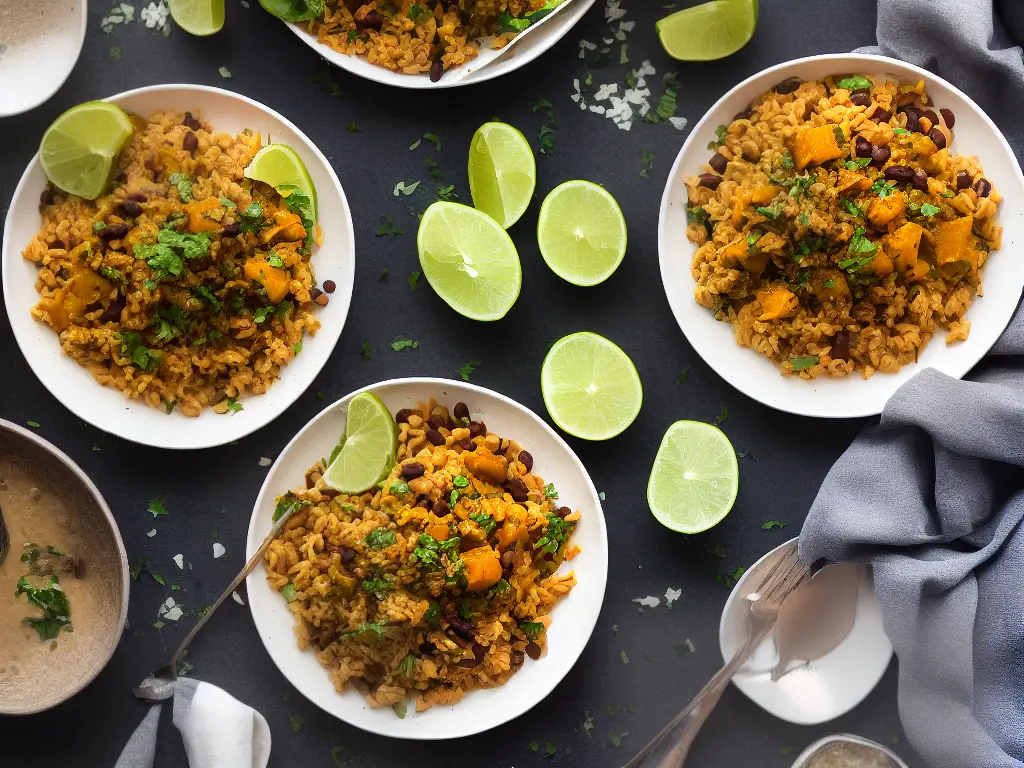
Types of Beans in Vegan Cuisine
Black beans, known for their earthy flavor and tender texture, are one of the most popular beans in vegan cuisine. They feature prominently in Latin American and Caribbean dishes, such as black bean soup and Cuban black bean rice. These versatile beans can also be crafted into delightful vegan black bean burgers, salads, spreads, and dips. Rich in protein, fiber, vitamins, and minerals, black beans are a nutritious choice for any vegan meal. Their dark color adds visual appeal, while their mild flavor serves as a perfect base to build upon with a variety of spices and herbs.
Another type of bean commonly used in vegan dishes are kidney beans. As the name suggests, they are kidney-shaped and have a deep, dark red color. Kidney beans have a robust and mildly sweet flavor, and their thicker skin gives them a firmer texture, making them popular in Indian and American cuisine. Often found in classic dishes like chili con carne, kidney beans can also be used in a vegan version of chili, incorporating a myriad of vegetables, spices, and meat substitutes. In addition, kidney beans can be included in salads, stews, and casseroles for added nutrition, flavor, and satisfying heartiness.
Pinto beans, known for their speckled appearance and creamy texture, are another versatile bean used in many vegan recipes. These beans are most commonly associated with Mexican cuisine, such as in refried beans or burritos, but their creamy texture and mild flavor make them adaptable to various dishes. Pinto beans can be cooked from dried or canned, and their ability to hold their shape when cooked makes them perfect for soups and stews. Vegans can also enjoy pinto beans mashed or pureed, making a creamy base for a dairy-free bean dip or spread. Packed with protein and fiber, pinto beans are a nutritious addition to any vegan meal.
Chickpeas, also known as garbanzo beans, play an essential role in vegan cuisine, especially in Mediterranean and Middle Eastern dishes. With their firm texture and nutty flavor, chickpeas can be tossed into salads, simmered into soups, roasted as a crunchy snack, or mashed into spreads like hummus. Chickpeas are also a great base for vegan protein-packed salads, as they can be combined with various vegetables, grains, and herbs for a delicious and satisfying meal. Additionally, chickpea flour is utilized in many vegan recipes as a gluten-free alternative to wheat flour, making it perfect for breading and frying vegetables, thickening sauces, or creating delicious flatbreads and fritters.
Lima beans, also known as butter beans due to their buttery flavor and smooth texture, make a great addition to vegan meals. Common in Southern American dishes like succotash, lima beans can also be utilized in various soups, stews, and casseroles. With a mild flavor, lima beans can be easily incorporated into almost any dish to provide plant-based protein and dietary fiber. Additionally, their smooth texture allows for creative uses such as making vegan-friendly dips, spreads, or even a creamy base for a dairy-free sauce. Lima beans are a flavorful and healthy choice to add to any vegan meal planning.
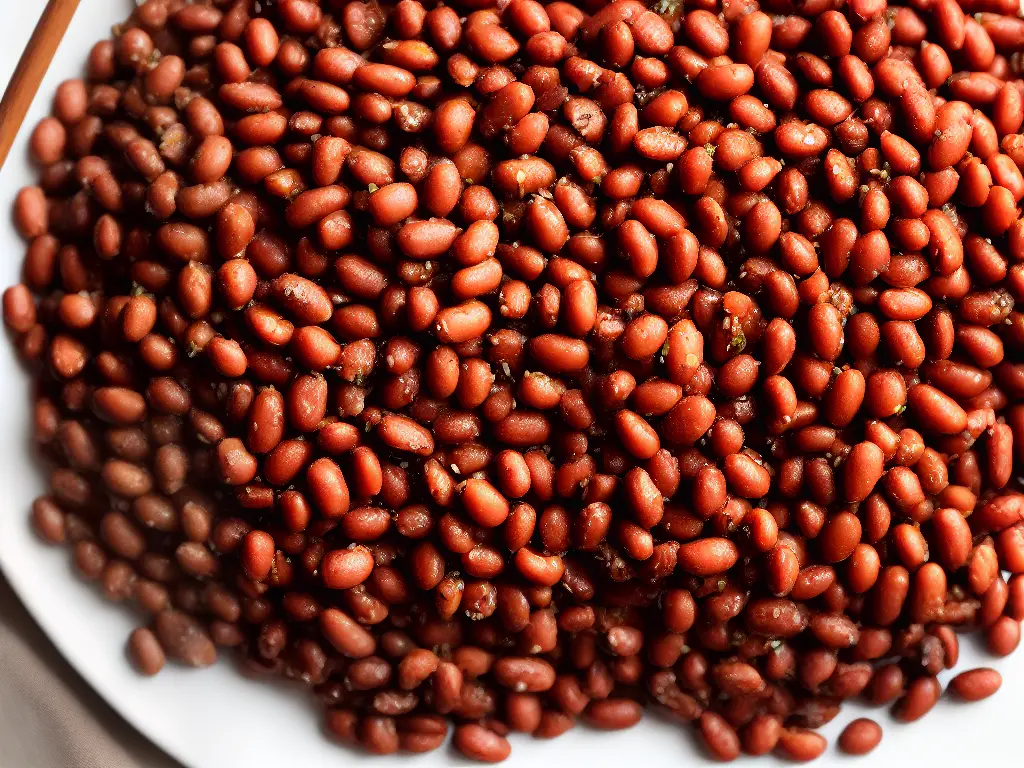
Methods for Preparing Beans for Vegan Dishes
To fully enjoy the benefits lima beans have to offer, proper preparation is essential. One popular method for preparing beans, especially in vegan bean dishes, is soaking and boiling. Soaking beans is important to reduce the cooking time and improve their digestibility. There are two methods for soaking beans: the overnight soak and the quick soak. In the overnight soak, beans are submerged in cold water for at least 8 hours, while in the quicker method, beans are boiled for a few minutes and then left to sit in the hot water for an hour. After soaking, the beans are drained and simmered in fresh water for 1 to 2 hours until they are tender. One advantage of this technique is that it helps to remove some of the indigestible sugars that cause gas and bloating. However, it can be time-consuming, and some nutrients may be lost in the soaking and boiling process. Regardless of the method selected, incorporating lima beans into your vegan dishes will provide a delicious and nutritious element to your meal.
Baking is another method to prepare beans for vegan dishes. Casseroles, such as bean and vegetable bake, are a popular example of baked bean dishes. Beans can be pre-soaked and partially boiled before baking, or they can be baked from dry if the dish has enough moisture and a long enough cooking time. Baking allows for better flavor infusion from spices and herbs and a delightful crust on top of the dish. However, it can be harder to control the consistency of the beans using this method.
Slow cooking techniques, such as using a Crock-Pot or a pressure cooker, can be efficient and convenient for preparing beans for vegan dishes. Slow cookers allow for hands-off cooking, and the long, slow simmering process helps to tenderize the beans and meld flavors, producing delicious and satisfying dishes. Pressure cookers, on the other hand, can cook beans much faster than other methods, even without soaking, due to the high-pressure environment inside the pot. The main disadvantage to using slow cookers is that they can take a long time to cook the beans, while pressure cookers can sometimes overcook the beans if not used properly.
In addition to the aforementioned methods, there’s also the option of using canned beans for vegan dishes, which can save time when it comes to meal preparation. Canned beans have already been soaked, cooked, and are ready to use. However, some disadvantages of using canned beans include the possible presence of added salt and other preservatives, as well as the potential loss of nutrients due to the canning process. To minimize the sodium content and preservatives, consider choosing low-sodium or no-added-salt canned beans and always rinse them well before using.
Vegan diets are on the rise, and many people are looking for alternative sources of protein to make sure they’re meeting their nutritional needs. One of the most popular options for vegans is beans, which are not only high in protein, but also rich in essential nutrients like fiber, iron, and folate. Bean-based protein sources such as tofu, tempeh, and seitan are versatile and make excellent main ingredients in vegan dishes.
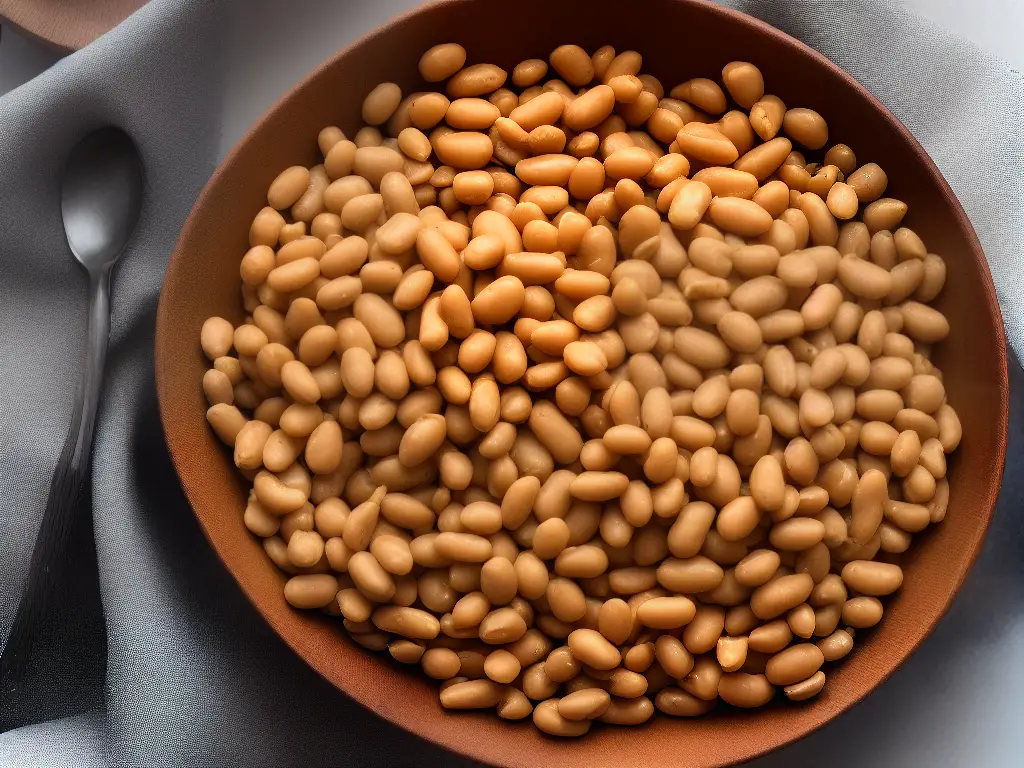
Bean-Based Proteins for Vegans
Another interesting method of preparing beans for vegan dishes is sprouting, which enhances the nutritional content. Sprouting increases the availability of certain vitamins and minerals, and makes the beans easier to digest by breaking down complex carbohydrates, thus reducing gas and bloating issues. To sprout beans, soak them in water for a few hours, drain, and then keep moist for a few days until small sprouts appear. Sprouted beans can be eaten raw, stir-fried, or added to salads, soups, and other dishes. However, the main disadvantage of sprouting beans is its time-consuming nature, taking several days to complete the process.
Tofu: Also known as bean curd, tofu is made from soy milk that has been curdled and pressed into various firmness levels. It contains all nine essential amino acids, making it a complete protein, and is available in varying textures, ranging from silken to extra-firm, each suited to different dishes. For instance, silken tofu can be used to make creamy sauces, while extra-firm tofu can be pan-fried or grilled for a chewier, more substantial texture. It readily absorbs the flavors of the other ingredients in the dish, making it suitable for a wide variety of recipes including stir-fries, salads, smoothies, and desserts.
Tempeh: Another soy-based product, tempeh is made by fermenting cooked soybeans with a specific type of fungus. It is higher in protein content than tofu and contains essential vitamins and minerals like magnesium and vitamin B6. With its firm, nutty texture, tempeh works well in dishes that require a hearty, protein-rich ingredient, such as sandwiches, salads, or stir-fries. It is also beneficial for gut health due to the presence of natural probiotics from the fermentation process.
Seitan: Made from wheat gluten, seitan is another bean-based protein option ideal for those who are soy-free. While it is not suitable for those with gluten intolerance, seitan is a great vegan alternative for individuals with no dietary restrictions. With a texture similar to meat, seitan is a versatile ingredient in vegan cooking and can be used in a variety of dishes, such as stews, stir-fries, and even as a substitute for bacon, steak, or chicken. In addition to being high in protein, seitan contains trace amounts of essential nutrients like iron and calcium.
Lentils and chickpeas are not only excellent bean-based proteins but are also versatile legumes that can be incorporated into a wide variety of dishes. Soups, stews, salads, and even plant-based burgers or meatballs are just a few examples of meals that can be enhanced with these nutritious beans. In addition to their health benefits, incorporating more bean-based proteins into your diet contributes to the sustainability of our planet by reducing the demand for animal-based proteins. As such, they are an ideal choice for vegans pursuing a delicious, nutritious, and cruelty-free lifestyle.
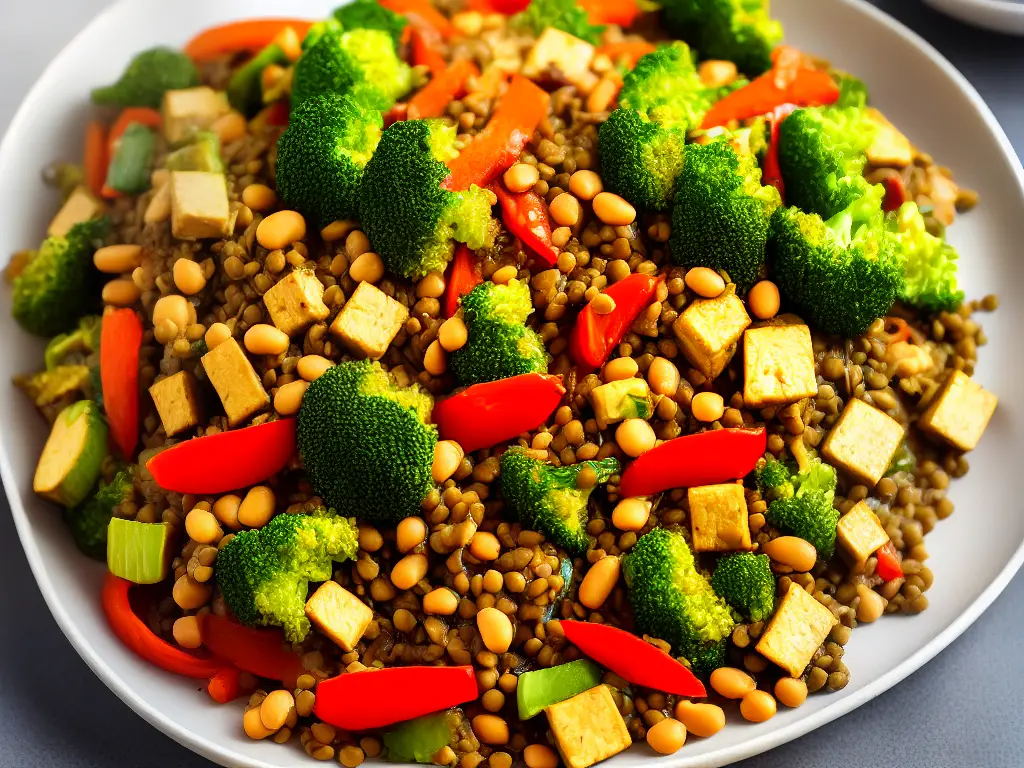
The Art of Flavorful Vegan Bean Dishes
Choosing the right herbs is a crucial step in creating a flavorful vegan bean dish. Fresh herbs like cilantro, parsley, and basil can be added just before serving to retain their bright flavors, while dried herbs such as oregano, thyme, and rosemary can be incorporated during the cooking process, allowing their flavors to meld with the beans. By experimenting with various combinations of herbs, you can unlock the full potential of vegan bean dishes, creating unique and satisfying meals that contribute to both your health and the health of the planet.
Spices also bring a depth of flavor to vegan bean dishes. Depending on the types of beans used and the desired taste, you can use spices to add warmth, sweetness, or a kick of heat to a dish. For example, adding cumin, coriander, and paprika can give a smoky and earthy flavor to your beans, while incorporating cinnamon, nutmeg, or cloves adds a slightly sweet note. To add a bit of heat, try incorporating chili powder, cayenne pepper, or ground black pepper to beans. Don’t be afraid to mix and match spices to achieve new and exciting flavors.
Another way to add flavor to vegan bean dishes is by using various cooking techniques. Slow cooking or simmering beans with spices allows the flavors to meld and develop, resulting in a rich, complex taste. Roasting beans in the oven, on the other hand, gives them a crispy texture and a slightly caramelized flavor. Finally, sautéing beans over medium heat with aromatic vegetables, such as onions, garlic, and bell peppers, can draw out the natural flavors of the beans while adding texture and depth to the dish.
Condiments are another essential way to enhance the taste of vegan bean dishes. For a tangy touch, consider adding vinegar, lemon or lime juice, or soy sauce to your beans. These acidic elements elevate the flavors and help balance any excess richness. To boost the savory umami flavor in your dish, consider incorporating tomato paste, miso paste, or nutritional yeast. For a sweeter note, using a touch of maple syrup, agave nectar, or even diced dried fruit like apricots can add a pleasant contrast to savory beans.
A versatile ingredient to consider in vegan bean dishes is coconut milk, which imparts a rich and creamy base to the recipe, without the need for dairy. This works exceptionally well in curries and makes it possible to achieve a lush and velvety texture. Additionally, do not underestimate the importance of salt in bringing out the flavors of your bean dish. While it’s important not to over-salt your food, a well-seasoned bean dish will taste more cohesive and satisfying. Finding the right balance between herbs, spices, and condiments ensures a delectable and delicious vegan bean feast, which can include soups and stews as well.
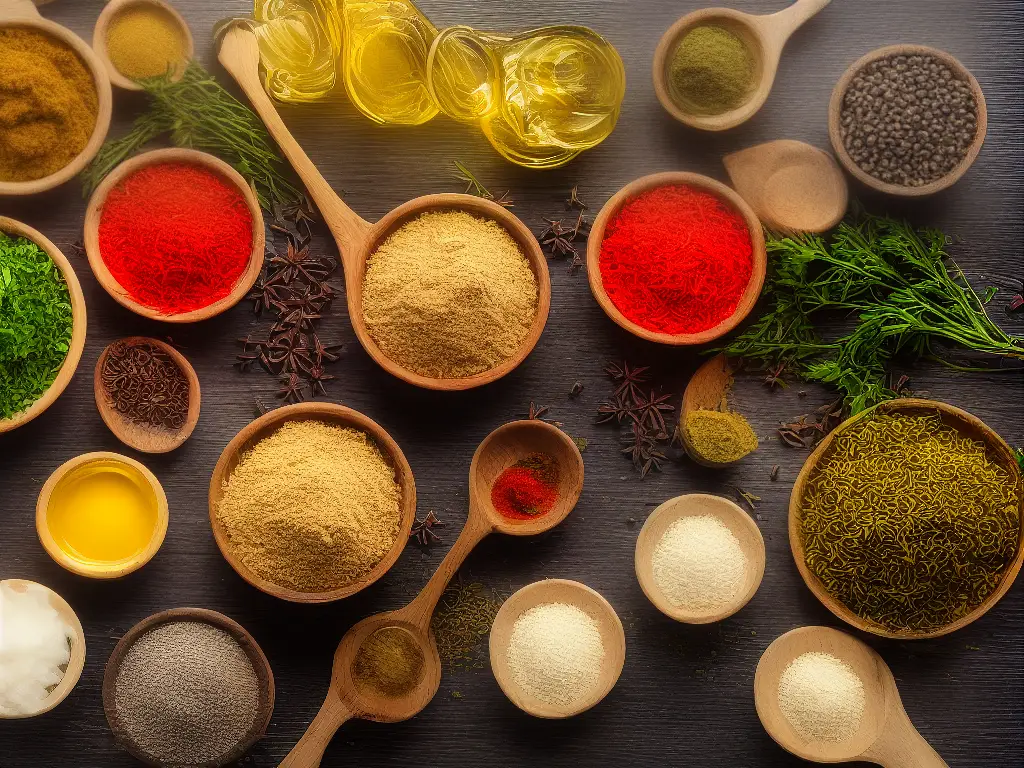
Vegan Bean Soups and Stews
Vegan bean soups and stews are a delicious and nutritious way to enjoy a variety of beans and legumes, as these dishes can also be flavored with coconut milk and well-seasoned. Packed with protein and fiber, they make an excellent choice for those who follow a plant-based diet. Combining different types of beans and legumes with a wide array of herbs, spices, and condiments will make your vegan bean dishes even more enticing and fulfilling, providing a well-rounded meal for you and your loved ones.
One popular vegan bean dish is lentil soup, which typically consists of cooked lentils and various vegetables such as onions, carrots, and celery. Lentil soup is a versatile dish that can be prepared with a wide range of flavors and seasonings, making it appealing to many different palates. Additionally, lentils come in several different varieties, such as green, brown, and red, each adding its unique taste and texture to the soup.
Another flavorful vegan bean dish is chili, which is traditionally made with kidney beans and a rich tomato sauce. Vegan chili can also include other types of beans such as black beans, pinto beans, or even chickpeas for added variety and nutrition. This hearty stew is often prepared with a mix of vegetables and spices for a robust flavor profile. Spices such as chili powder, cumin, and paprika can be added to the dish for a smoky, spicy taste. Toppings such as avocado, nutritional yeast, or vegan cheese can be added to enhance the dish further.
Minestrone is a classic Italian soup that typically contains a mix of vegetables, pasta, and beans. The beans used in minestrone are usually cannellini or Great Northern beans, giving the soup a creamy texture. This dish can be customized in various ways, with additional ingredients such as spinach, zucchini, or bell peppers. Flavorful herbs such as oregano, thyme, and basil add a delicious, fragrant aroma to the dish. To make minestrone soup more satisfying, whole wheat or gluten-free pasta can be added for a filling, high-fiber meal.
Developing rich flavors in vegan bean soups and stews is often achieved through slow cooking methods and layered seasoning. One way to add depth of flavor is by cooking the beans and vegetables in vegetable broth or stock instead of water. This imparts a more savory taste to the dish than water alone. Additionally, adding aromatic vegetables such as onions, garlic, and celery can create a hearty, satisfying base for the soup or stew. Cooking the spices with the vegetables in a bit of oil or vegan butter before adding the liquid can also help to release their flavors and enhance the taste of the dish.
Discovering new and delicious variations of your favorite vegan bean soups and stews is made easy by experimenting with the addition of various herbs, spices, and seasonings, as well as adjusting cooking times and temperatures. The inclusion of vinegars or citrus juices can add a subtle tang that complements the rich flavors of the beans and vegetables. Similarly, using unique ingredients such as sun-dried tomatoes, olives, or capers can add an exciting Mediterranean touch to traditional legume dishes. With endless possibilities for customization, vegan bean soups and stews offer a satisfying, nourishing, and flavorful dining experience.
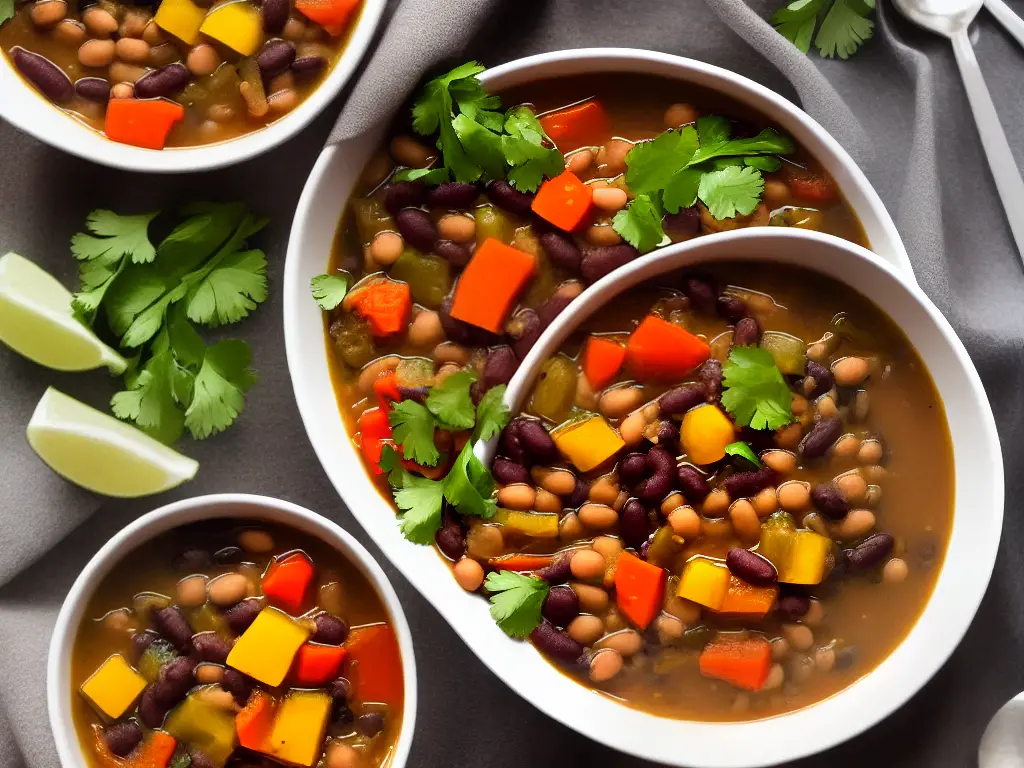
Vegan Bean Salad Ideas
Moving on from soups and stews, vegan bean salads are the perfect combination of healthy, satisfying, and delicious. One popular example is the three-bean salad, which traditionally consists of green beans, kidney beans, and garbanzo beans (also known as chickpeas). This salad can be easily customized by substituting or adding more types of beans, such as black beans or navy beans. The beans are mixed with chopped vegetables like bell peppers, onions, and celery, then dressed with a tangy vinaigrette made from apple cider vinegar, sugar, and Dijon mustard. This classic salad can be made ahead and gets even better as it marinates in the refrigerator overnight, making it an excellent companion to the aforementioned bean soups and stews.
Another delicious vegan bean salad option is the quinoa and bean salad. Quinoa, a nutritious and gluten-free grain, adds extra protein and fiber to the mix. This salad often highlights black beans, corn, cherry tomatoes, and avocado. The dressing typically uses lime juice, olive oil, cilantro, and seasonings like cumin and chili powder for a fresh and flavorful dish. This salad can be served cold or at room temperature and works great as a standalone meal or a side dish.
Mediterranean chickpea salad combines the wholesome goodness of chickpeas with a variety of vegetables like cucumber, cherry tomatoes, red onion, and Kalamata olives. The salad is seasoned with fresh herbs like parsley and mint, with a dash of salt and pepper. A simple lemon and olive oil vinaigrette further enhances the Mediterranean flavor. For a more substantial meal, this salad can be served atop a bed of baby spinach or mixed greens, or you can add more protein in the form of crumbled tofu or tempeh.
For a unique twist on a vegan bean salad, consider a lentil and sweet potato salad. Perfect for fall and winter, this dish incorporates cooked green lentils and roasted sweet potatoes, along with crunchy elements like pumpkin seeds and pomegranate arils. The dressing is a blend of maple syrup, Dijon mustard, and apple cider vinegar, which perfectly complements the sweet and earthy flavors in the salad. Additionally, this salad is packed with nutrients and vitamins, making it a wholesome and satisfying meal.
A vibrant and refreshing Asian-style edamame and soba noodle salad is an excellent way to enjoy vegan bean dishes. This salad features cooked soba noodles, shelled edamame (young soybeans), shredded vegetables like carrots and red cabbage, and is often garnished with toasted sesame seeds. The dressing is made from a flavorful combination of soy sauce, rice vinegar, ginger, garlic, and sesame oil, giving the salad an umami-rich taste. This versatile noodle salad can be further enhanced with the addition of other ingredients such as tofu or tempeh, making it even more satisfying and enjoyable.
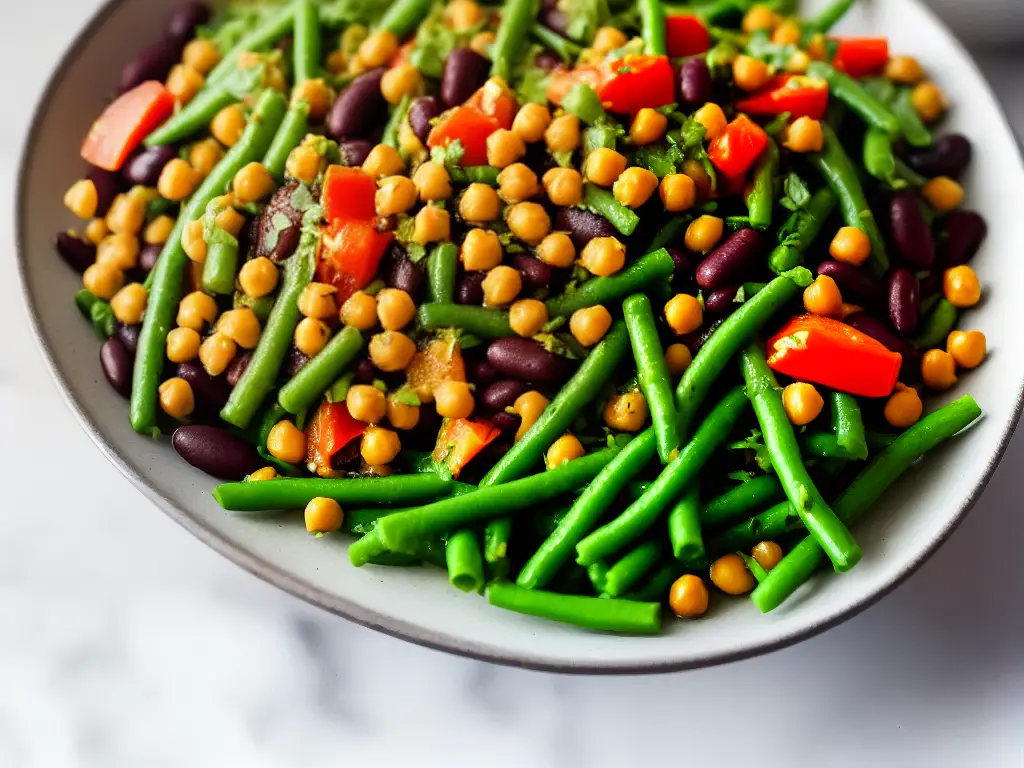
Delicious Vegan Bean Dishes
Moving on to another popular option, veggie burgers remain a classic choice for those seeking delicious and satisfying vegan bean dishes. With beans as the main ingredient, these burgers offer a healthy, high-protein alternative to traditional meat-based patties. Black beans, chickpeas, and even lentils can be used as the base, combined with a variety of spices, grains, and vegetables to create flavorful and filling burgers. Whether grilled outdoors or cooked on the stovetop, vegan bean burgers can be enjoyed on their own, on a bun, or crumbled over a salad to create a versatile centerpiece to any meal.
Bean casseroles also serve as hearty vegan bean-centered dishes, perfect for both weeknight dinners and special occasions. Combining a variety of beans with vegetables, grains, and vegan protein sources like tofu or tempeh creates a nutrient-dense and flavorful casserole that can be adapted to suit your taste preferences. For extra richness, consider adding vegan cheese or a creamy sauce to bind the ingredients together. Bean casseroles can also be customized with seasonally available ingredients and baked in the oven for a warming one-dish meal.
Stuffed peppers are another vegan bean dish that showcases the versatility of beans in plant-based recipes. Many types of beans, such as black beans, kidney beans, or pinto beans, make an excellent filling for hollowed-out bell peppers. These bean-stuffed peppers can be jazzed up with a mixture of spices, grains, vegetables, or vegan meats, like crumbled tofu, tempeh, or veggie crumbles. Baking the stuffed peppers in the oven, with or without a vegan cheese or tomato sauce topping, results in a flavorful and eye-catching dish that’s sure to impress both vegans and non-vegans alike.
Beans can also be incorporated into other vegan main dishes to create filling, protein-rich meals. Consider experimenting with bean-based soups, stews, and chilis for a warm and comforting option, or adding beans to your next stir-fry or curry recipe for extra protein and flavor. Additionally, beans can be mixed with grains, such as rice, quinoa, or couscous, to make satisfying salads or grain-based bowls.
One delightful way to include beans in vegan main dishes is by incorporating them into pasta and noodle recipes. Beans, like chickpeas or cannellini beans, make a delicious and nutritious addition to hearty tomato-based pasta sauces, or even as the base for a vegan pesto. Another option is to use bean-based pasta, like edamame or black bean noodles, which provide a gluten-free and protein-rich alternative to traditional pasta dishes. Pairing these dishes with a variety of vegetables and vegan proteins, like tofu or tempeh, will further bolster the flavor and nutritional value of these bean-centered meals.
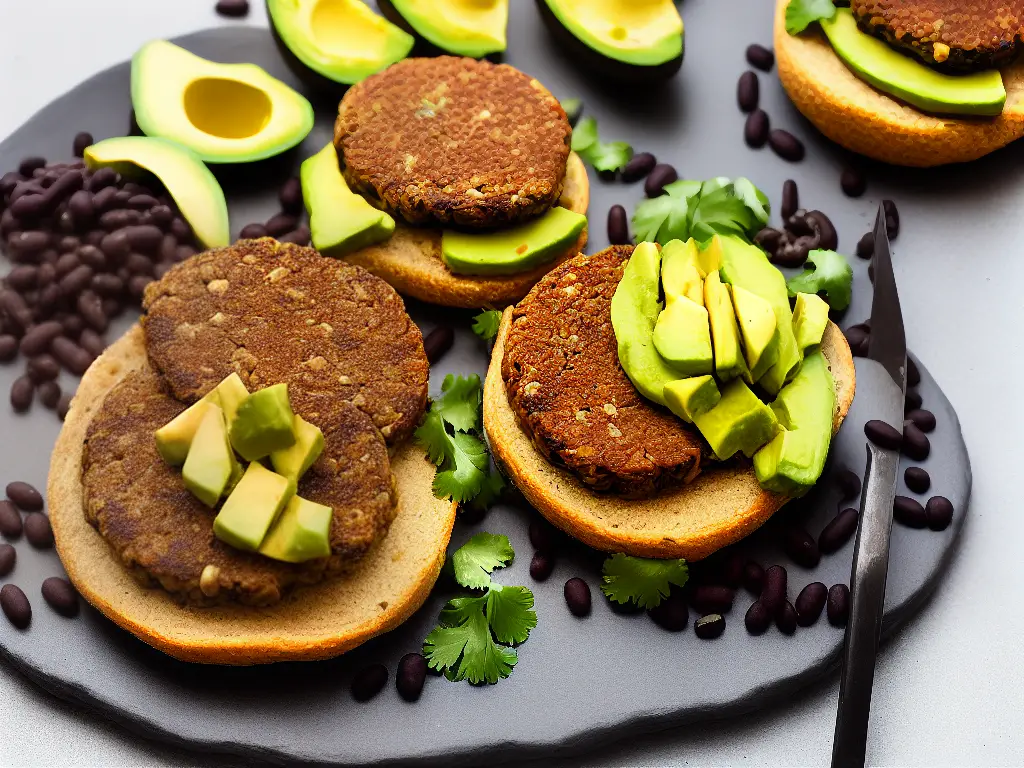
Vegan Snacks and Appetizers with Beans
Moving beyond main dishes, there is a plethora of unique and tasty ways to enjoy beans in the form of vegan snacks and appetizers. A classic and popular bean-based dip is hummus, typically made from chickpeas, tahini, lemon juice, garlic, and olive oil. This versatile appetizer can be paired with an array of foods, such as raw vegetables, pita bread, or tortilla chips. Furthermore, you can customize your hummus by adding a variety of flavors and spices, like roasted red pepper, sun-dried tomatoes, or a spicy kick of jalapeno, connecting back to the creativity found in incorporating beans into pasta dishes.
Another satisfying vegan bean snack is bean dip, which can be made with nearly any type of bean, including black beans, pinto beans, or cannellini beans. Like hummus, bean dips are easy to customize with your favorite spices, herbs, or additional ingredients, such as avocado, tomatoes, and corn. Bean dips provide a satisfying and healthy option on a snack platter, often accompanied by items like corn chips, whole grain crackers, or celery sticks. These dips are not only delicious but also are a valuable source of nutrients, packed with fiber and protein.
Taking a traditional appetizer concept and adding a vegan twist, bean fritters, and patties can be eaten on their own or as the base for sliders or bite-sized sandwiches. For instance, using chickpeas, lentils, or black beans, mix them with your choice of spices, herbs, and vegan binders like flax egg or oat flour to create a dough-like consistency. Shape the dough into patties or balls and then pan-fry, bake or air-fry them until crispy and golden brown. Serve the fritters on their own with a dipping sauce or as part of a mini sandwich with your favorite vegan toppings.
Spiced roasted chickpeas offer another nutritious and delicious option to satisfy your crunchy snack cravings. Start by draining and drying cooked or canned chickpeas, then toss them in a bit of oil and your favorite spices – such as smoked paprika, garlic powder, or cumin. Spread the chickpeas on a baking sheet and bake until they reach the desired level of crispiness. Roasted chickpeas are perfect for on-the-go snacking or can be added to salads for a crunchy, protein-packed element.
Vegan bean dishes are versatile, delicious, and healthy options for those seeking plant-based meals. With endless possibilities for customization and adjusting to personal tastes, bean-based dishes provide the opportunity to get creative while maintaining a wholesome and satisfying vegan diet. Whether you’re hosting a party, looking for an afternoon snack, or simply wanting to incorporate more beans into your meals, these appetizing options are perfect for all occasions.
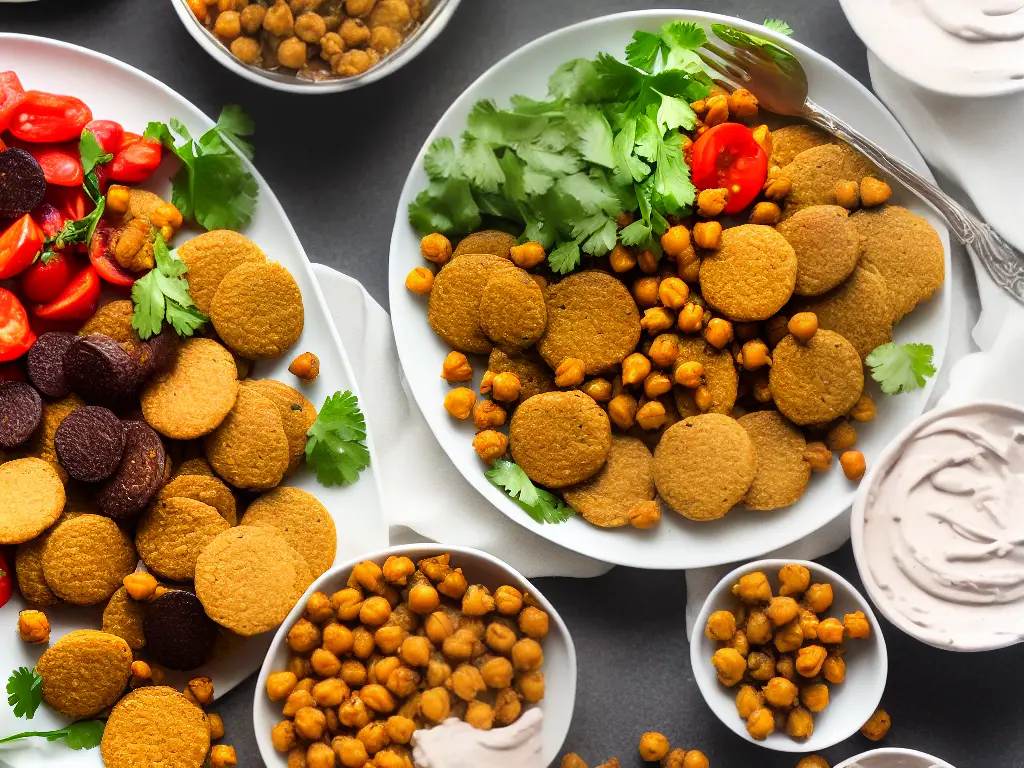
Vegan Bean Desserts
One such bean dish that has gained popularity is black bean brownies, which combine the rich, fudgy taste of a classic brownie with the nutritional benefits of black beans. The beans provide a solid foundation for the chocolatey treat, while also adding fiber, protein, and essential vitamins and minerals. To make black bean brownies, blend cooked black beans with ingredients such as cocoa powder, coconut oil, plant-based milk, and sweeteners like maple syrup or dates. Depending on your taste, you can also incorporate chocolate chips, nuts, or fruits to add extra flavor and texture to this satisfying dessert.
Another tantalizing option for those with a sweet tooth is chickpea cookie dough. Often made by blending cooked chickpeas with ingredients such as nut butter, maple syrup or agave for added sweetness, and vanilla extract for flavor, this vegan treat mimics the taste and texture of classic cookie dough – without the need for raw egg. Rich in protein and low in unhealthy fats, chickpea cookie dough can be enjoyed straight from the blender or refrigerated for a chilled, easy-to-scoop snack. Some popular variations of this dessert include adding chocolate chips, nuts, or dried fruit to resemble traditional cookie varieties.
For a taste of eastern-inspired vegan delights, adzuki bean ice cream is a must-try. Grinding cooked adzuki beans into a paste and incorporating that paste with a base of coconut milk or cashew cream, the outcome is a slightly sweet, flavorful and creamy dessert. The use of natural red bean paste in this dish gives the ice cream a vibrant and irresistible hue. This dish is not only known for its delicious flavor but is also appreciated for its high fiber and nutrient content, which is often not found in traditional ice cream options. To enhance the flavor and texture of adzuki bean ice cream, you can add extras such as crushed nuts or fruits like chopped mangoes.
Beans can be easily incorporated into various dessert options by simply sweetening and flavoring them appropriately. For instance, white beans can be utilized to make a chocolate mousse by blending them with cocoa powder and sweetener, providing a high-protein, silky-smooth dessert. Additionally, red lentils can be cooked down with sugar or maple syrup, creating a vegan caramel sauce that is perfect for drizzling over desserts or adding to other recipes. When it comes to vegan bean dishes, the possibilities are seemingly endless – all it takes is a bit of creativity and a willingness to explore unique flavor combinations.
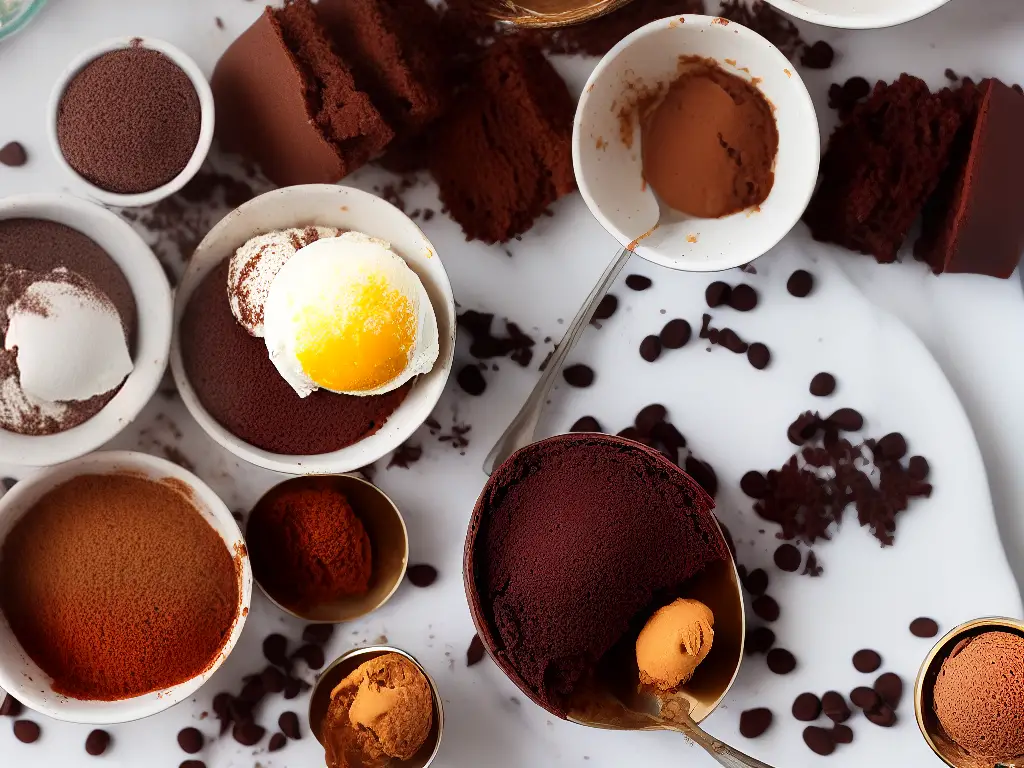
As you now know, vegan bean dishes offer an incredible range of flavors, textures, and culinary possibilities, with endless opportunities to experiment and create wholesome meals. By understanding the health benefits, various bean types, cooking techniques, seasonings, and bean-based proteins, you are fully equipped to craft delicious and nutritious vegan dishes. Whether you are a long-time vegan or just beginning your journey into plant-based eating, incorporating bean dishes into your meal rotation can transform your meals, enhancing both taste and nutritional value. So go ahead, open your pantry, and start exploring the wonderful world of vegan bean cuisine.